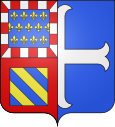Auxonne
| Auxonne | ||
|---|---|---|

|
|
|
| region | Bourgogne-Franche-Comté | |
| Department | Côte-d'Or | |
| Arrondissement | Dijon | |
| Canton | Auxonne (main town) | |
| Community association | Auxonne Pontailler Val de Saône | |
| Coordinates | 47 ° 12 ' N , 5 ° 23' E | |
| height | 181-211 m | |
| surface | 40.65 km 2 | |
| Residents | 7,622 (January 1, 2017) | |
| Population density | 188 inhabitants / km 2 | |
| Post Code | 21130 | |
| INSEE code | 21038 | |
| Website | http://www.auxonne.fr | |
 Auxonne on the banks of the Saône |
||
Auxonne is a French commune with 7,622 inhabitants (at January 1, 2017) in the department of Côte-d'Or in the region Bourgogne Franche-Comté . The city is the capital of the canton of the same name Auxonne .
geography
Auxonne is about 30 kilometers south-east of Dijon and 15 km north-west of Dole , on the left bank of the Saône . In terms of transport, the city is accessed by the A39 motorway, which runs just southwest of the city, and by the Dijon – Vallorbe railway line .
history
The county of Auxonne already existed here between the 10th and 13th centuries . Auxonne received city rights in 1229, and later it was even a mint . A castle protected the militarily important crossing over the Saône at the time. In 1237, Auxonne was exchanged for Duke Hugo IV of Burgundy, who , as a German fief, did not directly connect the Auxonnois to his duchy. After the death of Charles the Bold in 1477, the city fell to France.
At the end of the 15th century, the French King Louis XI. A fortified castle in Auxonne, still visible today, was built directly on the river bank. In the Peace of Madrid in 1526 King Francis I had to promise the cession of Auxonnese to Emperor Charles V , but it remained regardless and despite a siege by Lannoy and the associated area near France. In 1586 the city was conquered by the Duke of Guise during the Huguenot War. The aforementioned castle and the city walls were converted into a bastion with moats in the 17th century according to Vauban's concept . After stubborn resistance against the Austrians, the city surrendered to the Allies on August 28, 1815 under General Andréossy .
Population development
| year | 1962 | 1968 | 1975 | 1982 | 1990 | 1999 | 2007 | 2016 |
| Residents | 5704 | 5803 | 6485 | 7121 | 6781 | 7154 | 7717 | 7683 |
| Sources: Cassini and INSEE | ||||||||
Culture and sights
- Church of Our Lady from the 13th and 14th centuries
- Around 2/3 of the fortifications are still preserved
- Museum "Musée Bonaparte"
Personalities
- As a young lieutenant, Napoleon Bonaparte was stationed in the then garrison town (1787–1791) and wrote one of his earliest political writings here.
- Claude-Antoine Prieur , the officer, scientist and politician, was born in Auxonne
Town twinning
- Heidesheim am Rhein in Rheinhessen since 1964
